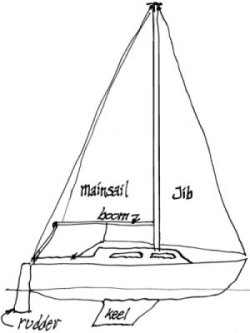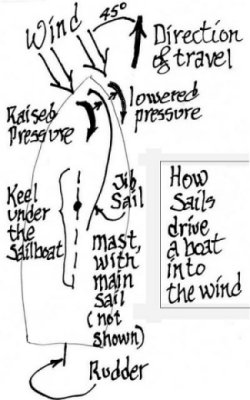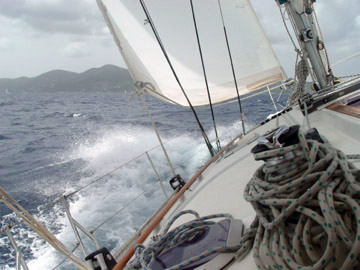Into the Wind
by John Price
Today, our guest, chaplain and sailor John Price, heads into the wind. The University of Houston presents this series about the machines that make our civilization run, and the people whose ingenuity created them.
 I was sailing a small boat being watched by a fishermen. When I sailed back to the dock, the fisherman said, "young fellow, I was watching you. You sailed right into the wind; how'd you do that?"
I was sailing a small boat being watched by a fishermen. When I sailed back to the dock, the fisherman said, "young fellow, I was watching you. You sailed right into the wind; how'd you do that?"
"Well, sir, the sails act just like the wing on an airplane; and, if I set them just right, head the boat in the correct direction relative to the wind, and shove my centerboard down thru its slot into the water below the boat, I can sail as much as 45 degrees into the wind. I'm pulled into the wind the way an airplane is pulled into the sky.
Well, I once invited John Lienhard to accompany me to my aqueous vector analysis laboratory. It took him a moment to realize that I was inviting him to go sailing. For the various forces acting on a sailboat really are a study in the vector analysis I learned in high school physics: Envision the wind as one vector, the water's force on the keel as a stability vector preventing the boat from being blown sideways, and the lift of the wind on the sails is a third. With the sails set correctly relative to the wind and the direction of the boat's travel, one can sail about 45 degrees into the wind and amaze the uninitiated.
 When we sail 45 to 60 degrees into the wind, we pull the forward sail -- the jib -- tight, and the mainsail as close to the center of the boat as possible. That creates a two-sided windfoil on each sail. As the wind divides past the led edge of the sail, half moves cross the forward edge of this windfoil, creating a bulge as the air movement speeds up just in that section, and according to Bernoulli's Principle, lowers the air pressure on that forward bulge.
When we sail 45 to 60 degrees into the wind, we pull the forward sail -- the jib -- tight, and the mainsail as close to the center of the boat as possible. That creates a two-sided windfoil on each sail. As the wind divides past the led edge of the sail, half moves cross the forward edge of this windfoil, creating a bulge as the air movement speeds up just in that section, and according to Bernoulli's Principle, lowers the air pressure on that forward bulge.
As the wind moves behind this windfoil, the sail, bulging forward, slows down the wind in that section. So the Bernoulli effect raises the air pressure on the aft side of the bulge. The resulting combination of those two processes really moves the boat through the water. The boat is pushed and pulled through the water.
As the skipper heads from point A to B, the centerboard or keel below the boat slices through the water in the direction the boat is traveling, and that serves as a stability vector to minimize the sideways movement, known to sailors as leeway. You don't really get to point B, but wind up at point C, a bit downwind from where you wanted to go -- unless you correct for it. And in some places, there's tidal motion to contend with -- yet another vector.
Until about 350 years ago, large sailing ships didn't have a rudder at the stern: it was off to one side and called a steering board. One could not put that side up to the dock, so the two sides became known as the port side and the steering board or starboard side. You can interpret their night-light colors by remembering: port wine is red.
Sailing has even more jargon -- for clarity's sake. There're no ropes on a sailboat; there're various kinds of lines -- sheets, halyards, and so forth. If the skipper had to say, "Adjust the forward sail's right control line," instead of "Trim the starboard jib sheet," the crew member facing aft would pick up the sheet on his right, the wrong jib sheet -- and we might run aground.
I'm John Price, and sailing is so much fun, it's to the high-tech point it is now because of the way inventive minds work.
For a demonstration of the Bournoulli effect on sails, see: http://www.catalin a-capri-25s.org/photo/razor2.jpg Observe the streaming wake behind the boat, showing the velocity at which the boat is propelled. We look directly into the wind as the boat moves off at a 45 degree angle from the wind, but "into the wind" relatively speaking. The sails are pulled in tight and the boat heels over considerably. The sailors try to use their weight to keep the boat as upright as possible. They should reduce the amount of sail deployed, as much of the wind is "being spilled." The boat would actually sail faster if they did so. See also: https://en.wikipedia.org/wiki/Tack_(sailing)
a-capri-25s.org/photo/razor2.jpg Observe the streaming wake behind the boat, showing the velocity at which the boat is propelled. We look directly into the wind as the boat moves off at a 45 degree angle from the wind, but "into the wind" relatively speaking. The sails are pulled in tight and the boat heels over considerably. The sailors try to use their weight to keep the boat as upright as possible. They should reduce the amount of sail deployed, as much of the wind is "being spilled." The boat would actually sail faster if they did so. See also: https://en.wikipedia.org/wiki/Tack_(sailing)
The Rev. John Price is a retired Episcopal priest, Army Chaplain, and Hospital Chaplain currently serving with Palmer Memorial Episcopal Church. He has been a sailor since 1971 and has skippered sailboats for years.

The Pride of Baltimore on port tack. (Image courtesy of Wikipedia.)